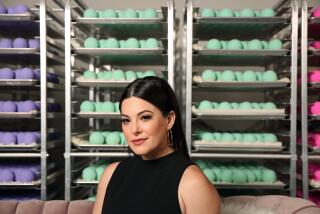Money Trouble Ends Pursuit of Cancer Drug
- Share via
A truck rolled out of an industrial strip mall near the 10 Freeway in Santa Monica, hauling the largest shipment ever to leave tiny Balance Pharmaceuticals Inc.: seven chemical drums containing thousands of doses of an investigational cancer-prevention drug called Libra.
It took Balance 11 years and nearly $25 million to reach that day -- its last in business. The drug stockpile that left the warehouse last month didn’t go to patients -- it went to an incinerator.
Balance lost a race faced by most of the nation’s 1,400 biotech firms: to develop a drug before the cash runs out. The biotech industry collectively loses billions of dollars a year pursuing complicated treatments that rarely make it to market. Driving them is the success of a few biotech giants, such as Amgen Inc. and Genentech Inc., that have hit the biotech lottery with a handful of multibillion-dollar drugs.
Balance’s experimental drug was a once-daily hormone nasal spray developed to prevent breast cancer. In theory, Libra worked by inducing chemical menopause to slow the division of cells in the breast. Scientists believed this would reduce the genetic mutations that in turn triggered breast cancer.
The results of human tests were encouraging, but Balance needed an additional $50 million to finish clinical trials.
“I never believed it would come to this,” said Chief Operating Officer AnnaMarie Daniels, whose husband, John Daniels, a USC oncologist, co-founded the company. Today, what remains of Balance is stored at the couple’s home: many boxes of documents and a small stash of Libra in their refrigerator -- enough for one more clinical trial.
One of the biggest disappointments from Balance’s failure wasn’t felt by its investors but by patients who volunteered to take the drug. Jodee Brooks, 42, of Orange, was on Libra for a year. Breast cancer runs in her family. Her sister had breast cancer and endured surgery, radiation and chemotherapy. Her mother and great-grandmother also had breast cancer.
So Brooks, the mother of two boys, and 13 other high-risk women used the Libra spray for a year in a clinical trial. Before they started on the drug, their mammograms showed fibrous clumps -- indicators associated with high cancer risk. After a year on Libra, the clumps were gone.
Women in the study complained about hot flashes and other menopausal symptoms, but none stopped taking Libra. Brooks said she once raced to hide in a department store dressing room after she broke out in a sweat. But her symptoms from Libra were trivial compared with what her sister suffered, she said.
“I wanted to keep taking it. It made me feel protected,” Brooks said.
After the drug trial, four women chose to have their healthy breasts or ovaries removed in hopes of avoiding breast cancer -- among the few choices available. Their doctor, Jeffrey Weitzel of City of Hope National Medical Center, said the clinical trial was too preliminary to establish Libra as an alternative to the surgeries -- an option he called “draconian.”
Balance grew out of two decades of research by Malcolm Pike, a USC medical statistician, who linked breast cancer risk and exposure to sex hormones -- now a widely accepted notion. In 1992, Pike teamed up with John Daniels and another USC oncologist, Darcy Spicer, to turn his theories into a commercial product.
From the start, the company ran into unforeseen obstacles. It took several years to develop the Libra nasal spray, much longer than expected. Later, regulatory delays and miscalculations about drug tests tripled the cost of clinical trials.
“I have been an academic my whole life,” said Pike, 68. “I really didn’t understand the enormous gamble ... and how much money is involved.”
Pike dreamed of marketing Libra as a contraceptive -- a use that would have made it available to thousands of women. To him, Libra offered an improvement on the birth control pill, which does not lower breast cancer risk. However, to sell Libra as a contraceptive, Balance would have had to test it in more than 1,000 women at a cost of $100 million or more.
Fibroid Treatment
In 1995, Balance was just a young company that had raised less than $4 million from family and friends. So the partners needed to lower their sights and find a less expensive way to bring Libra to market.
They decided to try Libra in women with fibroids, lumps of tissue that grow in the uterus and account for 240,000 hysterectomies a year. Fed by hormones, fibroids can cause pain and bleeding. They made ideal targets for Libra.
Clinical tests started in 1996 and showed promising results. Women in the study reported less pain and bleeding.
Fibroids account for 40% of hysterectomies, surgeries in which the uterus is removed, said Dr. Anthony Scialli, director of obstetrics and gynecology at Georgetown University Medical School. “It is a big problem.”
Balance soon reeled in additional financing. The National Cancer Institute awarded the company a modest grant to study the use of Libra in women with a high risk of breast cancer. This was the test that included Brooks.
After that, the company received $7 million from a New York investment firm, with promises of $5 million more when Libra moved closer to winning Food and Drug Administration approval. Other investors also had committed to the company. “We were feeling pretty high,” AnnaMarie Daniels said.
Balance plowed the money into new drug trials. By 2000, it had launched a second study in fibroids and a new test in women with endometriosis, a disease in which uterine tissue travels to other organs where it continues to grow.
The company’s fortunes soon unraveled. Balance underestimated the cost of clinical trials by a “factor of three,” said director Jeffrey Zucker. By 2001, Balance had burned through nearly $20 million and was running out of cash.
The company thought it had $2 million in new financing, but the investor pulled out after the Sept. 11 terrorist attacks. Balance laid off seven of its 15 employees that month, and could not meet its October 2001 payroll without a $100,000 loan from the Danielses.
“We were down to zero,” AnnaMarie Daniels said.
To keep the company going, the New York backer put up more money. And at the beginning of 2002, Balance hired former Schering-Plough Vice President Kathleen Hurtado as its chief executive with a single goal: to raise money.
Hurtado, 43, embraced the challenge. During her stint at Schering its oncology drug sales jumped to $800 million from $75 million.
Hurtado thought Balance’s clinical trial data looked good and if the FDA approved Libra the drug could ring up annual sales of $450 million.
“I thought it would be a slam dunk,” she said.
But Hurtado wasn’t prepared for the funding drought of 2002 as Nasdaq nose-dived. Financiers grumbled the potential market for Libra was small, others fretted it had limited patent protection and some questioned whether women would use a hormonal nasal spray.
“They had 400 reasons why it wouldn’t work,” Hurtado said.
In May 2002, Balance suffered a big setback when the FDA told Balance it needed to do a new fibroid study -- one that showed Libra was as effective as a hysterectomy, a high hurdle. A hysterectomy involves the surgical removal of the uterus and is a permanent cure for fibroids, whereas Libra wears off when women stop taking it.
Balance tried to negotiate with the FDA, arguing that many chronic illnesses, such as heart disease, were treated but not cured with drugs. But the agency would not budge. The company had spent $5 million on studies that appeared worthless at that point.
“It was devastating to us,” AnnaMarie Daniels said.
Frenzied Search for Cash
Hurtado desperately searched for additional money. She cold-called drug companies and medical device firms, she networked at medical conventions and at foundations. Hurtado had 100 meetings with venture funds and more with drug companies. Eventually, she accumulated 236,000 flying miles while hunting for financing, enough to have made a trip to the moon.
For inspiration, she hung a poster of a mud-splattered construction worker in her office, a space cluttered with unpacked boxes. The caption read: Either you are part of the steamroller or part of the pavement. “It reminded me to never give up,” she said.
By January, Hurtado warned Balance employees that if she couldn’t make a deal soon they would lose their jobs.
One possible backer was Neurocrine Biosciences Inc. in San Diego, a Wall Street darling with $245 million in cash.
Neurocrine business development boss Chrysa Mineo thought Libra looked like a good fit because her company had a pill in early human tests to treat endometriosis. Neurocrine could partner with Balance and get Libra to market to prepare doctors for its own drug, Mineo said.
But Mineo could not get the numbers to work. She thought the development costs of Libra were too high and Balance’s drug price forecasts were too aggressive. “There was no way we would ever make money,” she said.
Hurtado’s remaining prospects also turned her down. So she laid off everyone but her secretary and a part-time bookkeeper. Then she drove to her condo in Marina del Rey and climbed into bed.
On Sept. 12, Balance closed its doors.
AnnaMarie Daniels hopes her company’s scientific efforts will live on.
Weitzel has a modest grant from the National Cancer Institute and Avon to conduct a second study of Libra.
So, sometime this week, AnnaMarie Daniels plans to remove the 250 vials of Libra from her refrigerator and drive them to City of Hope, where Weitzel is director of clinical cancer genetics.
The test is too small to prove Libra works, but Balance hopes good results might attract the financing it needs to resurrect the drug.
“There still is a glimmer of hope,” AnnaMarie Daniels said.
More to Read
Inside the business of entertainment
The Wide Shot brings you news, analysis and insights on everything from streaming wars to production — and what it all means for the future.
You may occasionally receive promotional content from the Los Angeles Times.










